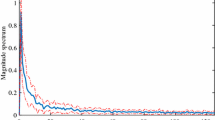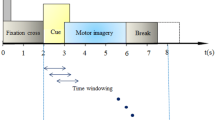Abstract
Features extracted from delta, theta, alpha, beta and gamma bands spanning low frequency range are commonly used to classify scalp-recorded electroencephalogram (EEG) for designing brain–computer interface (BCI) and higher frequencies are often neglected as noise. In this paper, we implemented an experimental validation to demonstrate that high frequency components could provide helpful information for improving the performance of the mental task based BCI. Electromyography (EMG) and electrooculography (EOG) artifacts were removed by using blind source separation (BSS) techniques. Frequency band powers and asymmetry ratios from the high frequency band (40–100 Hz) together with those from the lower frequency bands were used to represent EEG features. Finally, Fisher discriminant analysis (FDA) combining with Mahalanobis distance were used as the classifier. In this study, four types of classifications were performed using EEG signals recorded from four subjects during five mental tasks. We obtained significantly higher classification accuracy by adding the high frequency band features compared to using the low frequency bands alone, which demonstrated that the information in high frequency components from scalp-recorded EEG is valuable for the mental task based BCI.




Similar content being viewed by others
References
Vaughan, T. M., Heetderks, W. J., Trejo, L. J., Rymer, W. Z., Weinrich, M., Moore, M. M. et al, Guest editorial brain–computer interface technology: a review of the second international meeting. IEEE Trans. Neural Syst. Rehabil. Eng. 11:94–109, 2003. doi:10.1109/TNSRE.2003.814799.
Vaughan, T. M., and Wolpaw, J. R., The third international meeting on brain–computer interface technology: making a difference. IEEE Trans. Neural Syst. Rehabil. Eng. 14:126–127, 2006. doi:10.1109/TNSRE.2006.875577.
Graimann, B., Huggins, J. E., Levine, S. P., and Pfurtscheller, G., Toward a direct brain interface based on human subdural recordings and wavelet-packet analysis. IEEE Trans. Biomed. Eng. 51:954–962, 2004. doi:10.1109/TBME.2004.826671.
Wolpaw, J. R., Birbaumer, N., McFarlanda, D. J., Pfurtschellere, G., and Vaughan, T. M., Brain–computer interfaces for communication and control. Clin. Neurophysiol. 113:767–791, 2002. doi:10.1016/S1388-2457(02)00057-3.
Bashashati, A., Fatourechi, M., Ward, R. K., and Birch, G. E., A survey of signal processing algorithms in brain–computer interfaces based on electrical brain signals. J. Neural Eng. 4:R32–R57, 2007. doi:10.1088/1741-2560/4/2/R03.
Anderson, C. W., Devulapalli, S. V., and Stolz, E. A., EEG Signal classification with different signal representations, In: Proc. IEEE Workshop on Neural Networks for Signal Processing, pp. 475–483 Aug. 31–Sept. 2 1995.
Anderson, C. W., Stolz, E. A., and Shamsunder, S., Multivariate autoregressive models for classification of spontaneous electroencephalographic signals during mental tasks. IEEE Trans. Biomed. Eng. 45:277–286, 1998. doi:10.1109/10.661153.
Garrett, D., Peterson, D. A., Anderson, C. W., and Thaut, M. H., Comparison of linear, nonlinear, and feature selection methods for EEG signal. IEEE Trans. Neural Syst. Rehabil. Eng. 11:141–144, 2003. doi:10.1109/TNSRE.2003.814441.
Keirn, Z. A., and Aunon, J. I., A new mode of communication between man and his surroundings. IEEE Trans. Biomed. Eng. 37:1209–1214, 1990. doi:10.1109/10.64464.
Li, Z. W., and Shen, M. F., Classification of mental task EEG signals using wavelet packet entropy and SVM. In: Proc. 8th Int. Conf. on Electronic Measurement and Instruments, Xian, China, pp. 906–909 Aug. 16–July 18 2007.
Liu, H., Wang, J., and Zheng, C., Mental tasks classification and their EEG structures analysis by using the growing hierarchical self-organizing map. In: Proc. 1st Int. Conf. on Neural Interface and Control, Wuhan, China, pp. 115–118 May 26–28, 2005.
Palaniappan, R., Paramesran, R., Nishida, S., and Saiwaki, N., A new brain–computer interface design using fuzzy ARTMAP. IEEE Trans. Neural Syst. Rehabil. Eng. 10:140–148, 2002. doi:10.1109/TNSRE.2002.802854.
Palaniappan, R., Brain computer interface design using band powers extracted during mental tasks. In: Proc. 2nd Int. IEEE EMBS Conf. on Neural Eng., Arlington, Virginia, pp. 321–324, Mar. 16–19, 2005.
Palaniappan, R., Utilizing gamma band to improve mental task based brain–computer interface design. IEEE Trans. Neural Syst. Rehabil. Eng. 14:299–303, 2006. doi:10.1109/TNSRE.2006.881539.
Adeli, H., Ghosh-Dastidar, S., Dadmehr, N., and Wavelet-Chaos, A., Methodology for analysis of EEGs and EEG subbands to detect seizure and epilepsy. IEEE Trans. Biomed. Eng. 54:205–211, 2007. doi:10.1109/TBME.2006.886855.
Kronegg, J., Chanel, G., Voloshynovskiy, S., and Pun, T., EEG-based synchronized brain–computer interfaces: A model for optimizing the number of mental tasks. IEEE Trans. Neural Syst. Rehabil. Eng. 15:50–58, 2007. doi:10.1109/TNSRE.2007.891389.
Townsend, G., Graimann, B., and Pfurtscheller, G., A comparison of common spatial patterns with complex band power features in a four-class BCI experiment. IEEE Trans. Biomed. Eng. 53:642–651, 2006. doi:10.1109/TBME.2006.870237.
Ray, S., Niebur, E., Hsiao, S. S., Sinai, A., and Crone, N. E., High-frequency gamma activity (80–150 Hz) is increased in human cortex during selective attention. Clin. Neurophysiol. 119:116–133, 2008. doi:10.1016/j.clinph.2007.09.136.
Fitzgibbon, S. P., Pope, K. J., Mackenzie, L., Clark, C. R., and Willoughby, J. O., Cognitive tasks augment gamma EEG power. Clin. Neurophysiol. 115:1802–1809, 2004. doi:10.1016/j.clinph.2004.03.009.
Fatourechi, M., Bashashati, A., Ward, R. K., and Birch, G. E., EMG and EOG artifacts in brain computer interface systems: A survey. Clin. Neurophysiol. 118:480–494, 2007. doi:10.1016/j.clinph.2006.10.019.
Goncharova, I. I., McFarland, D. J., Vaughan, T. M., and Wolpaw, J. R., EMG contamination of EEG: spectral and topographical characteristics. Clin. Neurophysiol. 114:1580–1593, 2003. doi:10.1016/S1388-2457(03)00093-2.
Whitham, E. M., Pope, K. J., Fitzgibbon, S. P., Lewis, T., Clark, C. R., Loveless, S., Broberg, M., Wallace, A., DeLosAngeles, D., Lillie, P., Hardy, A., Fronsko, R., Pulbrook, A., and Willoughby, J. O., Sclap electrical recording during paralysis: Quantitative evidence that EEG frequencies above 20 Hz are contaminated by EMG. Clin. Neurophysiol. 118:1877–1888, 2007. doi:10.1016/j.clinph.2007.04.027.
Hyvarinen, A., and Oja, E., Independent component analysis: Algorithms and applications. Neural Netw. 13:411–430, 2000. doi:10.1016/S0893-6080(00)00026-5.
Jung, T. P., Makeig, S., Westerfield, M., Townsend, J., Courchesne, E., and Sejnowski, T. J., Removal of eye activity artifacts from visual event-related potentials in normal and clinical subjects. Clin. Neurophysiol. 111:1745–1758, 2000. doi:10.1016/S1388-2457(00)00386-2.
Li, R., and Principe, J. C., Blinking Artifact removal in cognitive EEG data using ICA. In: Proc. 28th Int. IEEE EMBS Conf., New York City, USA, pp. 5273–5276, Aug. 30–Sept. 3, 2006.
Vigario, R. N., Extraction of ocular artefacts from EEG using independent component analysis. Electroencephalogr. Clin. Neurophysiol. 103:395–404, 1997. doi:10.1016/S0013-4694(97)00042-8.
Vigario, R., Sarela, J., Jousmiki, V., Hamalainen, M., and Oja, E., Independent component approach to the analysis of EEG and MEG recordings. IEEE Trans. Biomed. Eng. 47:589–593, 2000. doi:10.1109/10.841330.
Xue, Z. J., Li, J., Li, S., and Wan, B. k., Using ICA to remove eye blink and power line artifacts in EEG. In: Proc. First Int. Conf. on Innovative Computing, Information and Control, Beijing, China, pp. 107–110, Aug. 2006.
Zhou, W., Zhou, J., Zhao, H., and Ju, L., Removing eye movement and power line artifacts from the EEG based on ICA. In: Proc. 27th Int. IEEE EMBS Conf., Shanghai, China, pp. 6017–6020, Sep.1–4, 2005.
Nam, H., Yim, T. G., Han, S. K., Oh, J. B., and Lee, S. K., Independent component analysis of ictal EEG in medial temporal lobe epilepsy. Epilepsia. 43:160–164, 2004. doi:10.1046/j.1528-1157.2002.23501.x.
Urrestarazu, E., Iriate, J., Alegre, M., Valencia, M., Viteri, C., and Artieda, J., Independent component analysis removing artifacts in ictal recordings. Epilepsia. 45:1071–1078, 2004. doi:10.1111/j.0013-9580.2004.12104.x.
Clercq, W. D., Vergult, A., Vanrumste, B., Paessche, W. V., and Huffel, S. V., Canonical correlation analysis applied to remove muscle artifacts from the electroencephalogram. IEEE Trans. Biomed. Eng. 53:2583–2587, 2006. doi:10.1109/TBME.2006.879459.
Lee, T. W., Girolami, M., and Sejnowski, T., ICA Using an extended infomax algorithm for mixed sub- and supergaussian sources. Neural Comput. 11:417–441, 1999. doi:10.1162/089976699300016719.
Hu, G. S., Digital signal processing: theory, algorithm and implementation. Tsinghua University Press, Beijing, 1997.
Acknowledgments
The authors would like to thank the anonymous reviewers for their valuable comments.
Author information
Authors and Affiliations
Corresponding author
Rights and permissions
About this article
Cite this article
Zhang, L., He, W., He, C. et al. Improving Mental Task Classification by Adding High Frequency Band Information. J Med Syst 34, 51–60 (2010). https://doi.org/10.1007/s10916-008-9215-z
Received:
Accepted:
Published:
Issue Date:
DOI: https://doi.org/10.1007/s10916-008-9215-z




